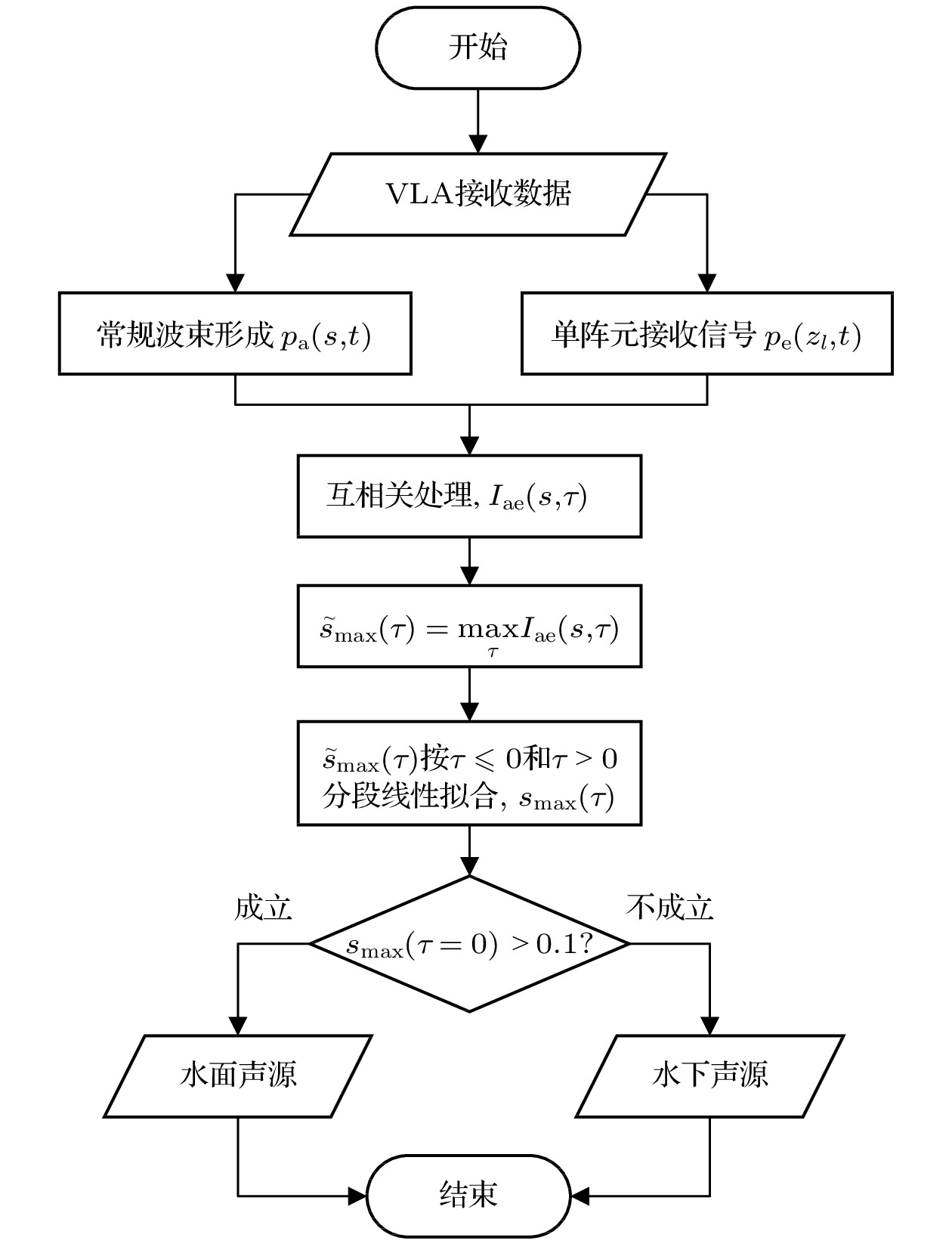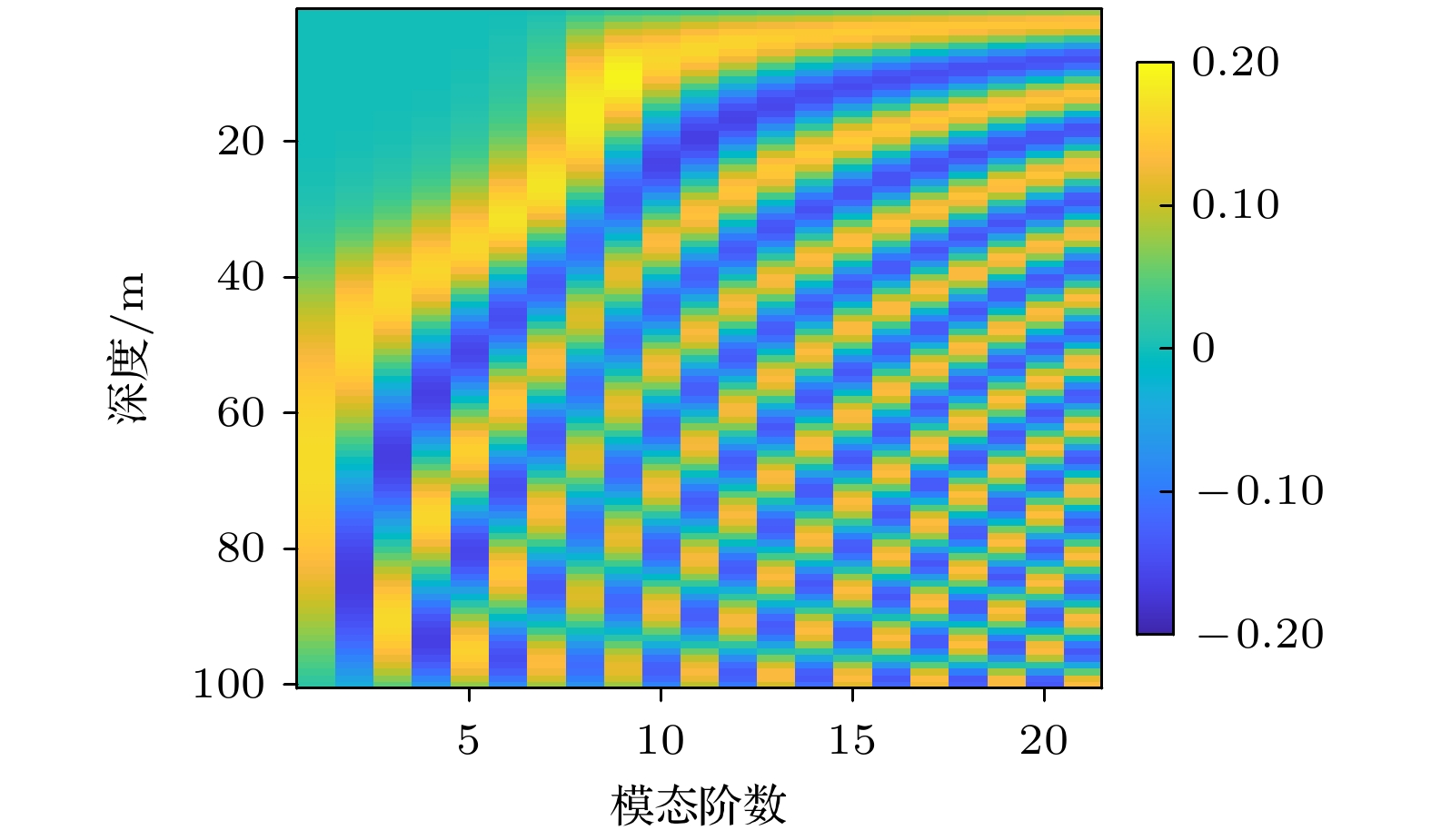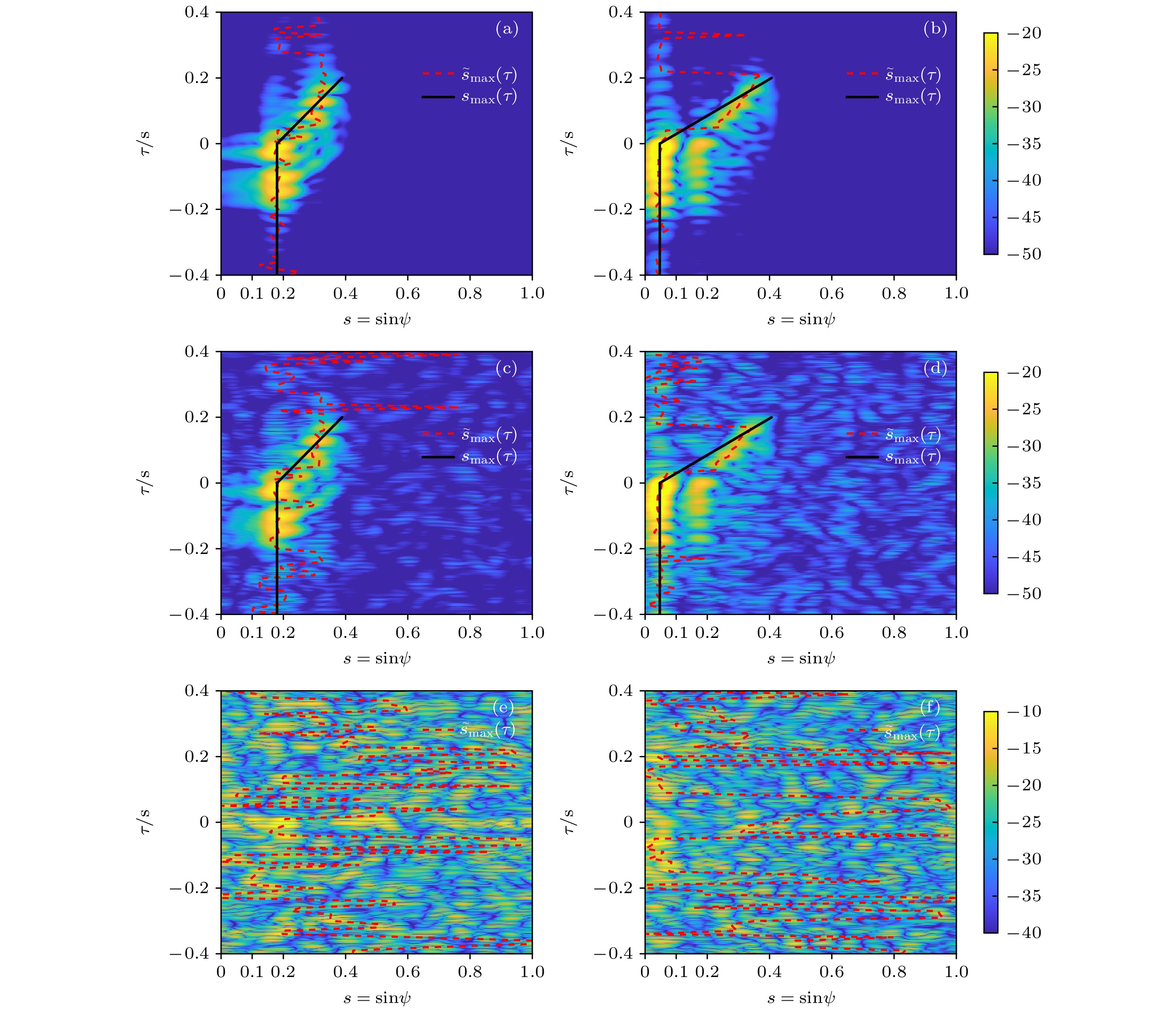-
针对浅海负跃层波导中的声源深度判别问题, 通过研究不同深度声源信号到达接收阵的简正波结构特征, 提出了一种利用互相关输出峰值迁移曲线的声源深度判别方法. 该方法利用浅海负跃层中主导简正波类型由声源深度决定这一先验信息, 根据峰值迁移曲线中互相关时延在0时刻的位置进行声源深度判别. 首先, 利用垂直线列阵波束输出与单阵元接收信号做互相关处理, 得到互相关时延—俯仰角输出二维图. 然后, 在图中提取不同时延上角度维峰值, 根据时延小于等于0、大于0的情况对所提取的峰值点进行分段线性拟合, 得到互相关输出峰值迁移曲线. 最后, 以曲线位于互相关时延为0时的位置进行声源深度判断. 理论分析表明, 曲线受波导中声速随深度变化的影响较小, 互相关时延0时刻位置的判别阈值由低阶简正波决定, 区分声源深度的区间由跃层的位置和厚度决定, 且跃层上下声速差越大越有利于声源深度判别. 仿真实验和海试数据分析结果表明, 该方法可有效进行声源深度判别, 并且无需模态分离、声源相对接收阵移动、精确声速剖面测量等前提条件.In this paper, the peak migration line of cross-correlation output is utilized to discriminate the depth of an underwater acoustic source in shallow water environment with a negative thermocline through studying the modal arrival structure of the source at different depths. The discrimination can be done according to the position of the migration line when the cross-correlation delay is zero since the type of dominant normal mode is determined by the depth of the source. Firstly, using the beam output of a vertical linear array and the received signal of a single array element to do cross-correlation processing, a two-dimensional intensity image of cross-correlation delay versus elevation angle is obtained. Then, the peaks in the angle domain at different delays can be extracted from the image. The cross-correlation peak migration line can be achieved by piecewise linear fitting which is divided into two parts corresponding to the delay being less than or equal to zero and the delay being more than zero, respectively. Finally, the source depth is determined by the position of the curve where the cross-correlation time delay is zero. Theoretical analysis shows that the migration line is little influenced by the sound velocity profile (SVP) varying with depth, the discrimination threshold is determined by the lower-order normal modes, the identification region is determined by the thickness and depth of the thermocline and the higher strength of the thermocline is instrumental in distinguishing. The numerical results and the experimental results prove the method's effectiveness which can be implemented without SVP details or mode separation, or source movement.
-
Keywords:
- negative thermocline in shallow water /
- peak migration line /
- source depth discrimination /
- normal mode
[1] Touzé G L, Nicolas B, Lacoume J L, Mars J, Fattaccioli D 2005 IEEE OCEANS Brest, France, June 20–23, 2005 p725
[2] Nicolas B, Mars J, Lacoume J-L 2006 EURASIP J. Adv. Signal Process. 2006 1
 Google Scholar
Google Scholar
[3] Courtois F L, Bonnel J 2015 J. Acoust. Soc. Am. 138 575
 Google Scholar
Google Scholar
[4] Lopatka M, Touzé G L, Nicolas B, Cristol X, Mars J, Fattaccioli D 2010 EURASIP J. Adv. Signal Process. 2010 1
 Google Scholar
Google Scholar
[5] Shang E C 1985 J. Acoust. Soc. Am. 77 1413
 Google Scholar
Google Scholar
[6] Neilsen T B, Westwood E K 2002 J. Acoust. Soc. Am. 111 748
 Google Scholar
Google Scholar
[7] Reeder B D 2014 J. Acoust. Soc. Am. 135 EL1
 Google Scholar
Google Scholar
[8] Yang T C 2015 J. Acoust. Soc. Am. 138 1678
 Google Scholar
Google Scholar
[9] Turgut A, Fialkowski L T, Schindall J A 2016 J. Acoust. Soc. Am. 139 EL184
 Google Scholar
Google Scholar
[10] 刘志韬, 郭良浩, 闫超 2019 声学学报 5 925
 Google Scholar
Google Scholar
Liu Z T, Guo L H, Yan C 2019 Acta Acust. 5 925
 Google Scholar
Google Scholar
[11] Jensen F B, Kuperman W A, Porter M B, Schmidt H 2011 Computational Ocean Acoustics (New York: Springer) pp739– 740
[12] Lee S, Makris N C 2006 J. Acoust. Soc. Am. 119 336
 Google Scholar
Google Scholar
[13] Gong Z, Ratilal P, Makris N C 2015 J. Acoust. Soc. Am. 138 2649
 Google Scholar
Google Scholar
[14] Ewing W M, Jardetzky W S, Press F 1957 Elastic Waves in Layered Media (McGraw-Hill: New York) pp341–367
[15] Premus V E, Helfrick M N 2013 J. Acoust. Soc. Am. 133 4019
 Google Scholar
Google Scholar
[16] Urick R J 1983 Principles of Underwater Sound (Vol. 3) (McGraw-Hill: New York) pp120–121
[17] 张仁和 1979 声学学报 2 102
 Google Scholar
Google Scholar
Zhang R H 1979 Acta Acust. 2 102
 Google Scholar
Google Scholar
[18] 高大治 2012 博士学位论文(青岛: 中国海洋大学)
Gao D Z 2012 Ph. D. Dissertation (Qingdao: Ocean University of China) (in Chinese)
[19] Weston D E. 1960 J. Acoust. Soc. Am. 32 647
 Google Scholar
Google Scholar
[20] Marine Physical Lab http://swellex96.ucsd.edu/index.htm [2021-10-19]
-
图 8 不同声源深度的
${I_{{\text{ae}}}}(s, \tau )$ ,${\tilde s_{\max }}(\tau )$ 和${s_{\max }}(\tau )$ (a)声源深度10 m, 白色虚线圈标注了峰裂分现象; (b)声源深度50 mFig. 8.
${I_{{\text{ae}}}}(s, \tau )$ ,${\tilde s_{\max }}(\tau )$ and${s_{\max }}(\tau )$ of sources at different depths: (a) Source at a depth of 10 m, with the peak splitting indicated by white dashed circle; (b) source at a depth of 50 m.图 10 不同声速差时不同声源深度的
${I_{{\text{ae}}}}(s, \tau )$ ,${\tilde s_{\max }}(\tau )$ 和${s_{\max }}(\tau )$ (a)$\Delta c$ = 0 m/s, 声源深度10 m; (b)$\Delta c$ = 0 m/s, 声源深度50 m; (c)$\Delta c$ = 40 m/s, 声源深度10 m; (d)$\Delta c$ = 40 m/s, 声源深度50 mFig. 10.
${I_{{\text{ae}}}}(s, \tau )$ ,${\tilde s_{\max }}(\tau )$ and${s_{\max }}(\tau )$ of sources at different depths with different$\Delta c$ : (a)$\Delta c$ = 0 m/s, source at a depth of 10 m; (b)$\Delta c$ = 0 m/s, source at a depth of 50 m; (c)$\Delta c$ = 40 m/s, source at a depth of 10 m; (d)$\Delta c$ = 40 m/s, source at a depth of 50 m.图 11 不同SNR条件下, 不同声源深度的
$ {I_{{\text{ae}}}}\left( {s, \tau } \right) $ ,${\tilde s_{\max }}(\tau )$ 和${s_{\max }}(\tau )$ (a) SNR = –10 dB, 声源深度10 m; (b) SNR = –10 dB, 声源深度50 m; (c) SNR = –20 dB, 声源深度10 m; (d) SNR = –20 dB, 声源深度50 m; (e) SNR = –25 dB, 声源深度10 m; (f) SNR = –25 dB, 声源深度50 mFig. 11.
$ {I_{{\text{ae}}}}\left( {s, \tau } \right) $ ,${\tilde s_{\max }}(\tau )$ and${s_{\max }}(\tau )$ of sources at different depths with different SNR: (a) SNR = –10 dB, source at a depth of 10 m; (b) SNR = –10 dB, source at a depth of 50 m; (c) SNR = –20 dB, source at a depth of 10 m; (d) SNR = –20 dB, source at a depth of 50 m; (e) SNR = –25 dB, source at a depth of 10 m; (f) SNR = –25 dB, source at a depth of 50 m.表 1 不同声源的频率
Table 1. Frequencies transmitted by different sources.
声源类型 频率/Hz J-13(9 m) 109 127 145 163 198 232 280 335 385 J-15(54 m) 49 64 79 94 112 130 148 166 201 235 283 338 388 -
[1] Touzé G L, Nicolas B, Lacoume J L, Mars J, Fattaccioli D 2005 IEEE OCEANS Brest, France, June 20–23, 2005 p725
[2] Nicolas B, Mars J, Lacoume J-L 2006 EURASIP J. Adv. Signal Process. 2006 1
 Google Scholar
Google Scholar
[3] Courtois F L, Bonnel J 2015 J. Acoust. Soc. Am. 138 575
 Google Scholar
Google Scholar
[4] Lopatka M, Touzé G L, Nicolas B, Cristol X, Mars J, Fattaccioli D 2010 EURASIP J. Adv. Signal Process. 2010 1
 Google Scholar
Google Scholar
[5] Shang E C 1985 J. Acoust. Soc. Am. 77 1413
 Google Scholar
Google Scholar
[6] Neilsen T B, Westwood E K 2002 J. Acoust. Soc. Am. 111 748
 Google Scholar
Google Scholar
[7] Reeder B D 2014 J. Acoust. Soc. Am. 135 EL1
 Google Scholar
Google Scholar
[8] Yang T C 2015 J. Acoust. Soc. Am. 138 1678
 Google Scholar
Google Scholar
[9] Turgut A, Fialkowski L T, Schindall J A 2016 J. Acoust. Soc. Am. 139 EL184
 Google Scholar
Google Scholar
[10] 刘志韬, 郭良浩, 闫超 2019 声学学报 5 925
 Google Scholar
Google Scholar
Liu Z T, Guo L H, Yan C 2019 Acta Acust. 5 925
 Google Scholar
Google Scholar
[11] Jensen F B, Kuperman W A, Porter M B, Schmidt H 2011 Computational Ocean Acoustics (New York: Springer) pp739– 740
[12] Lee S, Makris N C 2006 J. Acoust. Soc. Am. 119 336
 Google Scholar
Google Scholar
[13] Gong Z, Ratilal P, Makris N C 2015 J. Acoust. Soc. Am. 138 2649
 Google Scholar
Google Scholar
[14] Ewing W M, Jardetzky W S, Press F 1957 Elastic Waves in Layered Media (McGraw-Hill: New York) pp341–367
[15] Premus V E, Helfrick M N 2013 J. Acoust. Soc. Am. 133 4019
 Google Scholar
Google Scholar
[16] Urick R J 1983 Principles of Underwater Sound (Vol. 3) (McGraw-Hill: New York) pp120–121
[17] 张仁和 1979 声学学报 2 102
 Google Scholar
Google Scholar
Zhang R H 1979 Acta Acust. 2 102
 Google Scholar
Google Scholar
[18] 高大治 2012 博士学位论文(青岛: 中国海洋大学)
Gao D Z 2012 Ph. D. Dissertation (Qingdao: Ocean University of China) (in Chinese)
[19] Weston D E. 1960 J. Acoust. Soc. Am. 32 647
 Google Scholar
Google Scholar
[20] Marine Physical Lab http://swellex96.ucsd.edu/index.htm [2021-10-19]
计量
- 文章访问数: 5768
- PDF下载量: 84
- 被引次数: 0














 下载:
下载:



















































